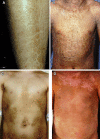Inherited Nonsyndromic Ichthyoses: An Update on Pathophysiology, Diagnosis and Treatment
- PMID: 28815464
- PMCID: PMC5797567
- DOI: 10.1007/s40257-017-0313-x
Inherited Nonsyndromic Ichthyoses: An Update on Pathophysiology, Diagnosis and Treatment
Abstract
Hereditary ichthyoses are due to mutations on one or both alleles of more than 30 different genes, mainly expressed in the upper epidermis. Syndromic as well as nonsyndromic forms of ichthyosis exist. Irrespective of etiology, virtually all types of ichthyosis exhibit a defective epidermal barrier that constitutes the driving force for hyperkeratosis, skin scaling, and inflammation. In nonsyndromic forms, these features are most evident in severe autosomal recessive congenital ichthyosis (ARCI) and epidermolytic ichthyosis, but to some extent also occur in the common type of non-congenital ichthyosis. A correct diagnosis of ichthyosis-essential not only for genetic counseling but also for adequate patient information about prognosis and therapeutic options-is becoming increasingly feasible thanks to recent progress in genetic knowledge and DNA sequencing methods. This paper reviews the most important aspects of nonsyndromic ichthyoses, focusing on new knowledge about the pathophysiology of the disorders, which will hopefully lead to novel ideas about therapy.
Conflict of interest statement
Conflict of interest
AV is the Editor of Acta Dermatovenereologica. JF and HT have no conflicts of interest to declare.
Funding
No funding was received for the preparation of this review.
Figures



References
-
- Brown SJ, Relton CL, Liao H, Zhao Y, Sandilands A, McLean WH, et al. Filaggrin haploinsufficiency is highly penetrant and is associated with increased severity of eczema: further delineation of the skin phenotype in a prospective epidemiological study of 792 school children. Br J Dermatol. 2009;161(4):884–889. doi: 10.1111/j.1365-2133.2009.09339.x. - DOI - PMC - PubMed
Publication types
MeSH terms
Substances
LinkOut - more resources
Full Text Sources
Other Literature Sources

